Towing a car without tow hooks might seem like an impossible task, but with the right equipment and techniques, it can be done safely and effectively. Whether you’re dealing with a car that has been in an accident or simply lacks accessible tow hooks, here’s how you can get it off the road and to the nearest repair shop.
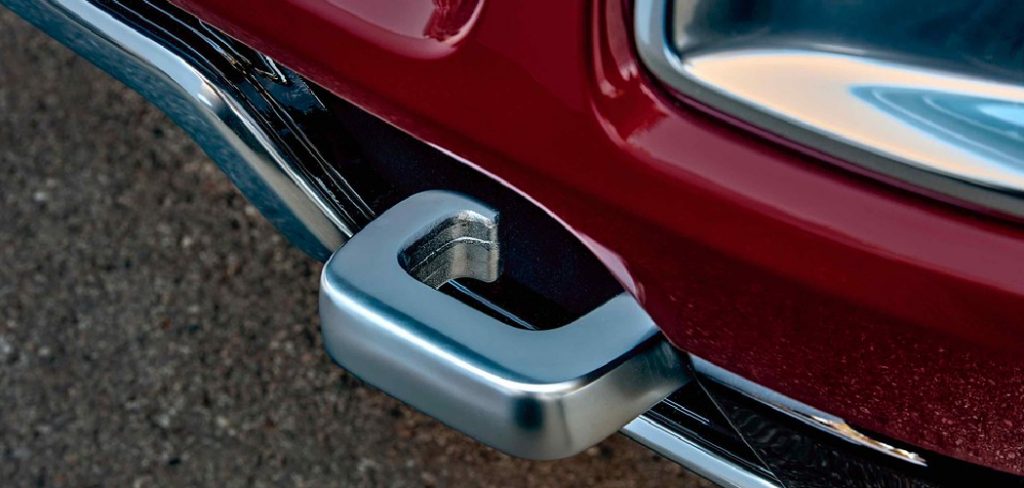
In this guide on how to tow a car without tow hooks, we’ll go over the necessary steps and equipment needed to tow a car without tow hooks.
Materials Needed
- Tow straps or ropes
- Heavy-duty gloves
- Carabiners or D-rings
- Jack stands (if available)
- Emergency warning triangles or flares (optional)
8 Things to Know Before You Start
1) Check for a Tow Hook Attachment Point
Before you start towing, it’s important to check if the car has any designated tow hook attachment points. Some cars have these near the front or rear bumpers, and they can usually be found by looking for small, circular covers with “TOW” written on them. If your car has these attachment points, you’ll need a tow hook adapter to safely attach the straps or ropes.
2) Choose Suitable Tow Straps or Ropes
When selecting tow straps or ropes, make sure they are strong enough to withstand the weight of the car being towed. Look for straps with a minimum breaking strength (MBS) of at least three times the weight of your car. It’s also important to check the straps for any tears or fraying before use.
3) Make Sure You Have Enough Space
Towing a car requires enough space for both vehicles to safely maneuver. Make sure you have at least 15 feet of clearance between both cars and avoid towing on busy roads or in tight spaces. If possible, try to tow the car from a parking lot or open area.
4) Prepare for Emergency Situations
In case of an emergency, it’s important to have the necessary safety equipment on hand. This can include emergency warning triangles or flares to alert other drivers, as well as a first aid kit in case of any injuries.
5) Use Heavy-Duty Gloves
When handling tow straps or ropes, it’s important to protect your hands with heavy-duty gloves. This will not only prevent any cuts or blisters but also provide better grip and control when towing. As an extra precaution, consider using carabiners or D-rings to secure the straps in place.
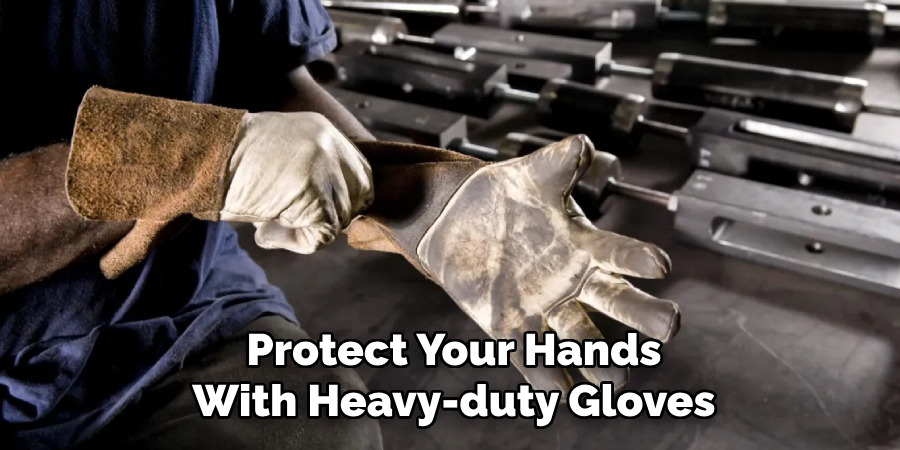
6) Use Jack Stands if Available
If the car being towed is not in neutral or doesn’t have functioning brakes, it may be necessary to use jack stands. These will hold the wheels in place and prevent them from turning during towing. Make sure to place the stands on a solid and level surface for added stability.
7) Communicate Effectively with the Other Driver
Clear communication is key when towing a car without tow hooks. Make sure to establish hand signals or use a designated communication device, such as walkie-talkie, to communicate effectively with the other driver. This will ensure that both vehicles are moving at the same pace and in the same direction.
8) Drive Slowly and Carefully
Finally, when actually towing the car, it’s important to remember to drive slowly and carefully. Avoid sudden acceleration or braking, and use smooth and gradual movements to prevent any jerking or swaying of the towed vehicle. This will not only keep both drivers safe but also prevent any further damage to the car being towed.
Towing a car without tow hooks may seem daunting, but with proper preparation and communication, it can be done safely and effectively.
Remember to always check for designated tow hook attachment points, use suitable equipment, have enough space to maneuver, prepare for emergencies, protect your hands with gloves, use jack stands if necessary, communicate clearly with the other driver, and drive slowly and carefully. By following these steps, you can safely get a car without tow hooks off the road and to its destination for repair.
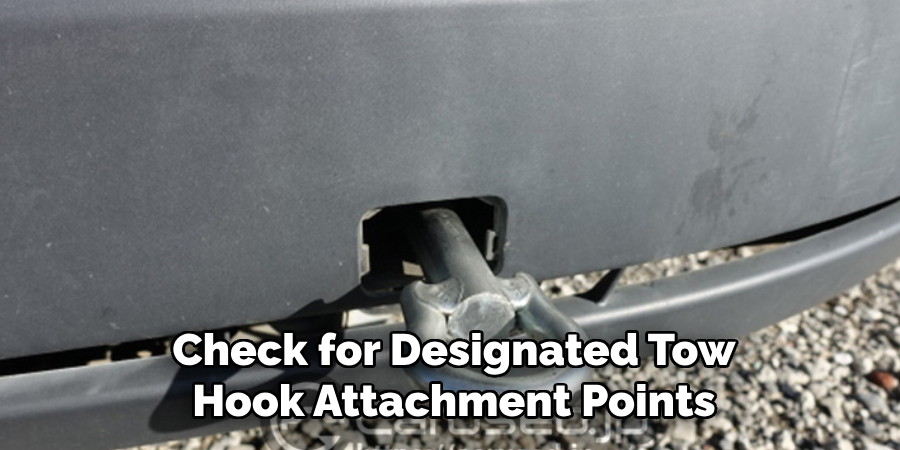
12 Steps on How to Tow a Car Without Tow Hooks
Step 1: Prepare the Towing Vehicle
Before you start towing, make sure the vehicle doing the towing is ready. Check that it has enough fuel, adequate tire pressure, and functioning brakes. As an extra precaution, you can also attach a tow strap to the towing vehicle’s frame or bumper in case of any mishaps.
Step 2: Check for Tow Hook Attachment Points
As mentioned previously, it’s important to check if the car has designated tow hook attachment points. If they are available, attach the tow straps to these points using a suitable adapter. If not, continue to the next step.
Step 3: Identify a Solid Attachment Point on the Disabled Car
If there are no designated tow hook attachment points, you’ll need to find a solid and sturdy part of the car’s frame or undercarriage to attach the straps. Avoid attaching them to any plastic parts or areas that may be weakened due to damage.
Step 4: Attach Tow Straps to Both Vehicles
Attach one end of the tow straps to the designated attachment points on the towing vehicle and the other end to the solid attachment point on the disabled car. Make sure the straps are tightly secured, and there is no slack.
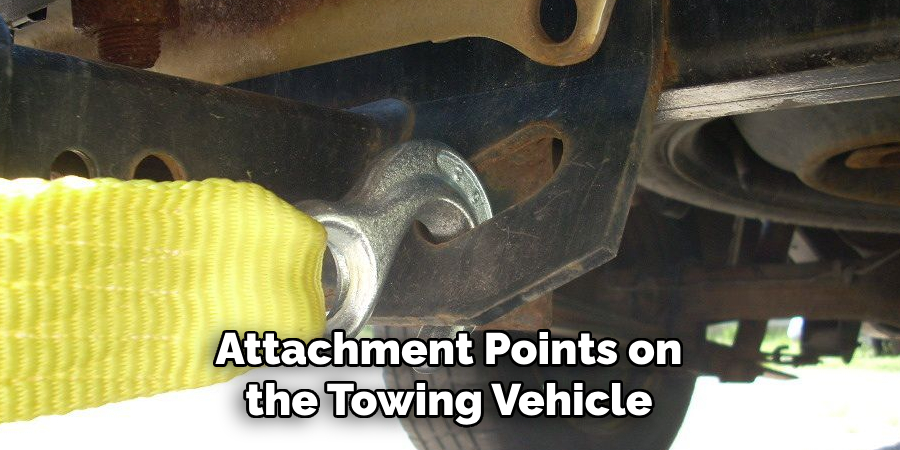
Step 5: Communicate with Other Driver
Before starting to tow, communicate clearly with the other driver and establish a designated communication method. This can include hand signals or using walkie-talkies. And remember, the driver of the disabled car should always be in control of steering and braking.
Step 6: Slowly Begin Towing
Once all communication is established and both drivers are ready, slowly start towing. Make sure to accelerate smoothly and gradually to prevent any jerking or swaying of the disabled car. While towing, maintain a safe and steady speed.
Step 7: Watch for Any Warning Signs
While towing, keep an eye out for any warning signs from the disabled car. If you notice any smoke, strange noises, or smells, immediately pull over to assess the situation. It may be necessary to stop and readjust the tow straps if they have become loose or damaged.
Step 8: Avoid Quick Movements
When towing, it’s important to avoid any sudden or quick movements. This includes acceleration, braking, and turning. Smooth and gradual movements will help keep both vehicles stable and prevent any accidents.
Step 9: Use Hazard Lights
To alert other drivers on the road, make sure to turn on your hazard lights while towing. This will increase visibility and help prevent any potential accidents. While driving, make sure to also maintain a safe distance from other vehicles.
Step 10: Prepare for Stops
If you need to come to a stop while towing, make sure to do so gradually and with enough time. Avoid sudden stops or jerky movements that can cause the disabled car to collide with the towing vehicle.
Step 11: Unhook Tow Straps Properly
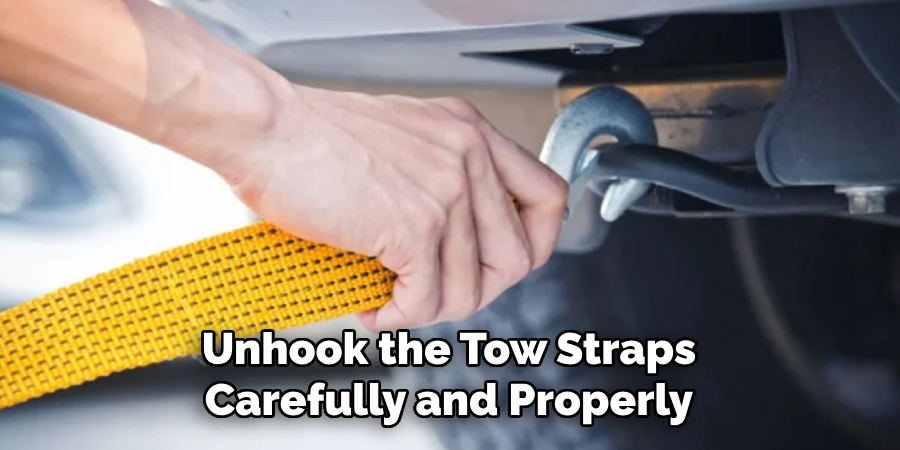
When you reach your destination, make sure to unhook the tow straps carefully and properly. This involves making sure there is no tension on the straps before removing them from the attachment points.
Step 12: Check for Any Damage
After the towing is complete, take some time to inspect both vehicles for any damage. Look for scratches, dents, or other signs of wear and tear. If necessary, take the disabled car to a mechanic for further inspection. These steps on how to tow a car without tow hooks may seem like a lot, but they are crucial in ensuring safe and effective towing without tow hooks.
By following them, you can successfully get a disabled car off the road and to its destination for repairs. Remember to always prioritize safety and proper preparation when towing any vehicle.
8 Things to Avoid When Towing a Car Without Tow Hooks
1) Attaching to Plastic Parts
When towing a car without tow hooks, it’s important to avoid attaching the straps to any plastic parts. These can easily break and cause damage to both vehicles. However, if there are no other options, make sure to reinforce the plastic parts with sturdy materials.
2) Sudden Acceleration or Braking
Avoid any sudden acceleration or braking while towing. These quick movements can cause jerking and swaying in the disabled car, which can lead to accidents. Instead, use smooth and gradual movements when driving.
3) Overloading the Tow Straps
Always make sure to use tow straps that are rated for the weight of the disabled car. Overloading the straps can cause them to break or snap, putting both vehicles at risk. But don’t use straps that are too large either, as they can become loose and cause damage.
4) Using Damaged Tow Straps
Inspect the tow straps before each use to ensure they are in good condition. If you notice any signs of wear or damage, do not use them. It’s important to always have functioning and sturdy tow straps when towing a car without tow hooks.
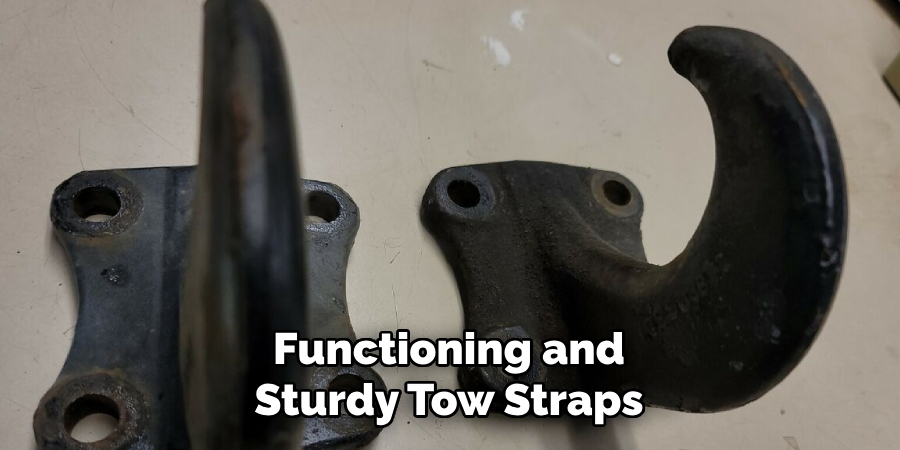
5) Towing at High Speeds
Towing a car without tow hooks requires extra precaution, and one of the ways to ensure safety is by driving at a safe and steady speed. Avoid going over the speed limit or driving too fast, as this can increase the risk of accidents.
6) Not Communicating with Other Drivers
Effective communication with the other driver is crucial when towing a car without tow hooks. Make sure to establish a designated communication method and use it consistently throughout the towing process.
7) Not Checking for Warning Signs
While towing, always keep an eye out for any warning signs from the disabled car. This can include smoke, strange noises, or smells. If you notice anything out of the ordinary, pull over and assess the situation before continuing.
8) Neglecting to Prepare for Stops
When towing a car without tow hooks, it’s important to always be prepared for stops. This means allowing enough time to come to a gradual stop without any sudden movements.
Sudden stops can cause the disabled car to collide with the towing vehicle, causing damage or accidents. By avoiding these common mistakes, you can ensure a safe and successful towing experience without tow hooks. Always prioritize safety and proper preparation when it comes to towing any vehicle.
Towing a car without tow hooks may seem daunting at first, but by following the necessary steps and avoiding certain mistakes, it can be done safely and effectively. Make sure to communicate with the other driver, use hazard lights, and maintain a steady speed while towing.
Remember to always prepare for stops and inspect both vehicles for any damage after the towing is complete. By prioritizing safety and proper preparation, you can successfully tow a car without tow hooks and get it safely to its destination for repairs.
8 Additional Tips for Towing a Car Without Tow Hooks
1) Use a Tow Dolly or Flatbed Trailer
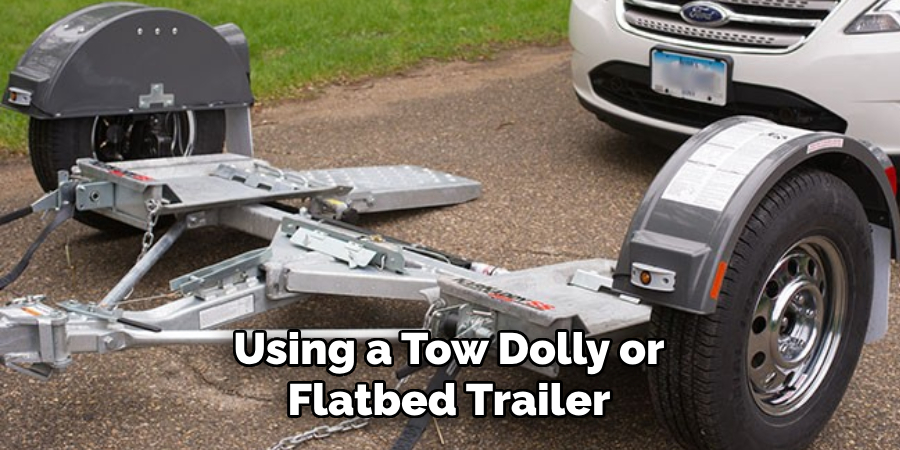
If the disabled car has all-wheel drive or is inoperable, using a tow dolly or flatbed trailer may be the best option. This will lift and secure the entire vehicle instead of just the front or rear end. To use a tow dolly, simply drive the disabled car’s front wheels onto the dolly and secure it with straps. For a flatbed trailer, back up the towing vehicle to align with the trailer and then load the disabled car onto it.
2) Use Properly Rated Tow Straps
Make sure to use tow straps that are rated for the weight of the disabled car. Refer to the manufacturer’s instructions and avoid overloading or using straps that are too large.
3) Drive with Caution
When towing a car without tow hooks, it’s important to always drive with caution. This means maintaining a steady speed, avoiding sudden movements, and being aware of any warning signs from the disabled car.
4) Use Braking Assistance
Towing a heavy car without tow hooks can put additional strain on the towing vehicle’s braking system. Consider using a braking assistance device, such as an electronic brake controller, to help distribute the braking force evenly.
5) Disengage Cruise Control
Make sure to disengage cruise control when towing a car without tow hooks. This feature may not respond well to the added weight and can cause unintended acceleration or braking. If possible, use manual shifting instead of automatic transmission.
6) Secure Loose Parts
Before towing, make sure to secure any loose parts on the disabled car. This includes side mirrors, antennas, and any other parts that may cause damage or become detached during towing. While securing these parts, also make sure to avoid attaching straps directly to them.
7) Use Proper Lighting
Proper lighting is crucial when towing a car without tow hooks. Make sure to use hazard lights and brake lights on both vehicles while driving. If possible, attach additional lighting equipment to clearly indicate the presence of the disabled vehicle on the road.
8) Practice Towing in a Safe Area
If you’re new to towing, it’s always a good idea to practice in a safe and empty area before hitting the road. This will help you get familiar with the handling of both vehicles and give you confidence when towing on busy roads. By following these additional tips on how to tow a car without tow hooks, you can ensure a safe and successful experience when towing a car without tow hooks.
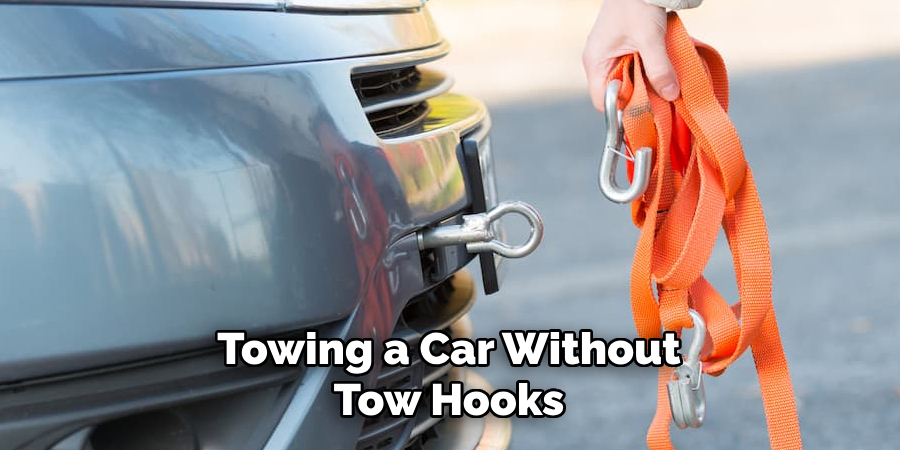
Remember to always prioritize safety and proper preparation for a smooth and problem-free towing process. Now that you know the dos and don’ts of towing a car without tow hooks, you can confidently help out a friend or family member in need or tackle any emergency situation with ease.
Frequently Asked Questions About Towing a Car Without Tow Hooks
Can Any Car Be Towed Without Tow Hooks?
Most cars can be safely towed without tow hooks, but it’s always best to consult the vehicle’s owner manual for specific towing instructions. In some cases, using a tow dolly or flatbed trailer may be necessary.
Can I Tow a Car Without Tow Hooks by Myself?
It’s always recommended to have at least two people when towing a car without tow hooks. This will allow for better communication and ensure safety while on the road.
Are There Any Special Tools Needed for Towing Without Tow Hooks?
Aside from tow straps, you may also need a trailer or dolly, an electronic brake controller, and additional lighting equipment. It’s important to have all the necessary tools and equipment before attempting to tow a car without tow hooks.
How Fast Should I Drive When Towing Without Tow Hooks?
It’s best to maintain a steady speed of 45-50 mph when towing a car without tow hooks. Avoid sudden movements, and always drive with caution.
Do I Need to Disconnect the Driveshaft When Towing Without Tow Hooks?
For rear-wheel-drive cars, it’s recommended to disconnect the driveshaft when towing without tow hooks. This will prevent damage to the transmission. Refer to the vehicle’s owner manual for specific instructions. Remember, safety should always be the top priority when towing a car without tow hooks.
By following these additional tips and FAQs, you can ensure a smooth and successful towing experience without any complications or accidents. Always prepare in advance, communicate with the other driver, and drive with caution to get the disabled vehicle safely to its destination for repairs.
Conclusion
Towing a car without tow hooks may seem intimidating, but with the right tools and knowledge on how to tow a car without tow hooks, it can be done safely and effectively. Make sure to use properly rated tow straps, communicate with the other driver, and drive with caution. Consider using a tow dolly or flatbed trailer if necessary, and always practice in a safe area before hitting the road.
By following these tips and precautions, you can confidently handle any towing situation without tow hooks. So the next time a friend or family member needs a helping hand with their car troubles, you’ll be ready to step in and save the day! Remember, always prioritize safety and proper preparation for a successful and stress-free towing experience.

About
JeepFixes Team is a skilled author for Jeep Fixes, bringing 6 years of expertise in crafting a wide range of jeep fixes. With a strong background in jeep fixes work, JeepFixes Team’s knowledge spans various types of fixtures, from decorative pieces to functional hardware, blending precision with creativity. His passion for jeep fixes and design has made him a trusted resource in the industry.
Professional Focus:
Expert in Jeep Fixes : JeepFixes Team aesthetic specializes in creating durable and innovative jeep fixes, offering both appeal and functionality. His work reflects a deep understanding of jeep fixes techniques and materials.
Sustainability Advocate : He is dedicated to using sustainable practices, ensuring that every fixture is crafted with eco-friendly methods while maintaining high-quality standards.
In his writing for jeep fixes, JeepFixes Team provides valuable insights into the latest trends, techniques, and practical advice for those passionate about jeep fixes, whether they are professionals or DIY enthusiasts. His focus on combining artistry with engineering helps others discover the true potential of jeep in design.
